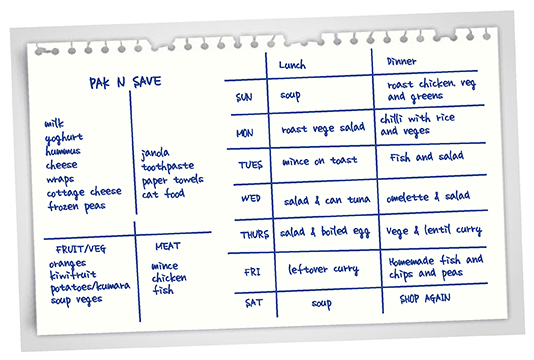The Power of Planning
When the clock approaches 5pm does the dinner panic begin to set in? With some planning and preparation the 5 o’clock panic can be a thing of the past.
The Benefits
Planning your weekly meals can have a big impact on both your health and budget. Getting into a good routine with planning your meals can make life so much easier. You know what your meals will look like and what you need to buy. It makes grocery shopping more efficient and cuts down on unplanned trips to buy one or two items. Going to the supermarket with grocery list in hand makes it a lot easier to resist those impulse purchases.
The Basics
Variety is good as it ensures we get what we need to keep our bodies functioning well. If you don’t have any special dietary requirements then each week aim to have:
- Red meat: two meals per week
- Chicken: one to two meals per week
- Fish/Seafood: two meals per week
- Vegetarian: one to two meals per week
- When planning meals it is always good to start with dinner as dinner is usually the hardest meal to prepare for.
Step 1: Start with ‘protein’ first e.g. meat, chicken, fish, eggs, lentils etc and base your meal around the protein portion.
Step 2: Look at what vegetables you can add or use to make up half a plate
Step 3: What carbohydrates go with the meal? Pasta, rice, potato, kumara?
Some things to consider
- Look for sales. What’s on special this week at the supermarket?
- Stock your pantry. That can of beans in the back of the cabinet could be the starting point for any number of healthy meals.
- Think seasonal. What fresh produce is available this time of year? Is it salad season or soup weather?
- Mix things up. Keep the menu interesting by alternating new recipes and old favourites.
A step by step guide to POWER planning:
 Step 1 – Get an A4 piece of paper, fold it in half
Step 1 – Get an A4 piece of paper, fold it in half
Step 2 – On one side of the paper – scribble a quick table with the days of the week you are shopping for and lunch and dinner columns
Step 3 – On the other side – put the name of your supermarket and then butcher/fruit and veg if you buy those things separately
Step 4 – Start with dinners – decide what you would like for the week – think NOW about when you are going out, what you have got on etc.
Step 5 – Then, work out what things you can use from dinner the night before for a lunch the next day e.g. if you have chilli – then it’s mince on toast, after a roast dinner – roast veggie salad
Step 6 – On the day when leftovers won’t make anything for lunch, what else can you have? Soup? Sandwiches? Wraps, salad – jot it down so you know what you are having
Step 7 – Write your shopping list on the other side of the page – start with what you need for dinners, then lunch and then think about the basics you need – cereal, milk, yoghurt, snacks etc.
Step 8 – Now add the extras you may need Janola, paper towel etc.
Step 9 – Shopping time
Step 10 – Pop the plan on the fridge so everyone knows what you are having! You may end up with 2 or 3 things in each box if you are catering for a few different lunches

